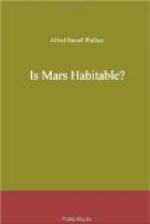Lowell on the System of Canals as a whole.
We will now see what Mr. Lowell claims to be the plain teaching of the ‘canals’ as a whole:
“But last and all-embracing in its import is the system which the canals form. Instead of running at hap-hazard, the canals are interconnected in a most remarkable manner. They seek centres instead of avoiding them. The centres are linked thus perfectly one with another, an arrangement which could not result from centres, whether of explosion or otherwise, which were themselves discrete. Furthermore, the system covers the whole surface of the planet, dark areas and light ones alike, a world-wide distribution which exceeds the bounds of natural possibility. Any force which could act longitudinally on such a scale must be limited latitudinally in its action, as witness the belts of Jupiter and the spots upon the sun. Rotational, climatic, or other physical cause could not fail of zonal expression. Yet these lines are grandly indifferent to such competing influences. Finally, the system, after meshing the surface in its entirety, runs straight into the polar caps.
“It is, then, a system whose end and aim is the tapping of the snow-cap for the water there semi-annually let loose; then to distribute it over the planet’s face” (p. 373).
Here, again, we have curiously weak arguments adduced to support the view that these numerous straight lines imply works of art rather than of nature, especially in the comparison made with the belts of Jupiter and the spots on the sun, both purely atmospheric phenomena, whereas the lines on Mars are on the solid surface of the planet. Why should there be any resemblance between them? Every fact stated in the above quotation, always keeping in mind the physical conditions of the planet—its very tenuous atmosphere and rainless desert-surface—seem wholly in favour of a purely natural as opposed to an artificial origin; and at the close of this discussion I shall suggest one which seems to me to be at least possible, and to explain the whole series of the phenomena set forth and largely discovered by Mr. Lowell, in a simpler and more probable manner than does his tremendous assumption of their being works of art. Readers who may not possess Mr. Lowell’s volume will find three of his most recent maps of the ‘canals’ reproduced in Nature of October 11th, 1906.




